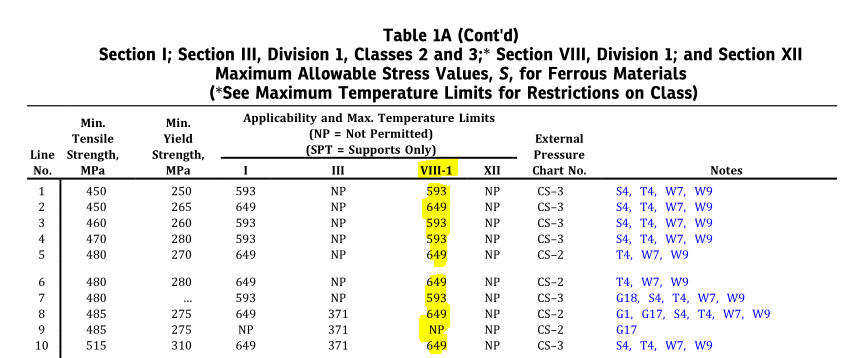Why is an ASME material unusable at a certain temperature despite having the allowable and yield strength values?
In the ASME context, the characteristics of the materials are defined in Section II, Part D. This standard contains multiple tables that summarize the general characteristics of the materials and their mechanical characteristics measured at various temperatures.
It may happen that in a project at a high temperature, a material is selected which has the characteristics up to that temperature and beyond. Nonetheless, when selecting material, NextGen shows a message indicating that this material is not selectable:
Material XXX can't be selected, design temperature is over maximum material temperature
The reason lies in the fact that the maximum temperature of a material is not the maximum temperature for which it has the mechanical characteristics, but a tabulated static value.

An extract from table 1A
Section II Part D is a standard common to several Divisions of ASME BPVC and the temperature limit is a value determined by the material and its context of use, which may have little to do with the availability of temperature characteristics.
How can this be resolved?
ASME provides all material usage data and states in ASME II Part D:
The information in the Applicability and Maximum Temperature Limits columns is mandatory. Where a material is permitted for use in more than one Construction Code, and in the SI units version of these tables, the maximum use temperature limit in these columns is critical. The temperature to which allowable stress or design stress intensity values are listed is not necessarily the temperature to which use is permitted by a particular Construction Code. Different Construction Codes often have different use temperature limits for the same material and condition. Further, values may be listed in the stress tables at temperatures above the maximum use temperature limit. These stress values are provided to permit interpolation to be used to determine the allowable stress or design stress intensity at temperatures between the next lowest temperature for which stress values are listed and the maximum‐use temperature limit listed in these columns.
Furthermore, in ASME VIII Div. 1 UG 20(c):
Design temperatures that exceed the temperature limit in the applicability column shown in Section II, Part D, Subpart 1, Tables 1A, 1B, and 3 are not permitted. In addition, design temperatures for vessels under external pressure shall not exceed the maximum temperatures given on the external pressure charts.
Before proceeding with any modification, it is recommended that the user ensures that such modifications comply with applicable regulations and are adequate for the intended use of the pressure equipment.
Before finalizing or using any calculations based on the changed properties, it is essential that the user agrees and validates the changes with the inspector or the competent authority in charge of reviewing and approving the calculations.
Search the documentation
Customer area
Categories
Articles in this category
- How to create a custom material
- Material characteristics customization
- Materials set feature and its usage
- Why is an ASME material unusable at a certain temperature despite having the allowable and yield strength values?
- Why do some ASME materials lack the yield strength, tensile strength, elasticity or thermal expansion values?
- How to import an ASME VIII material from Division 1 to Division 2 or vice-versa
- Request to insert materials not available in the NextGen database